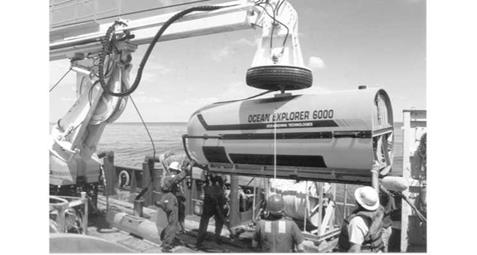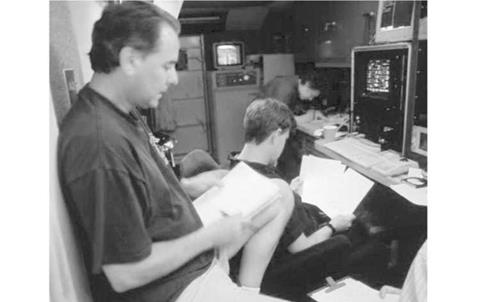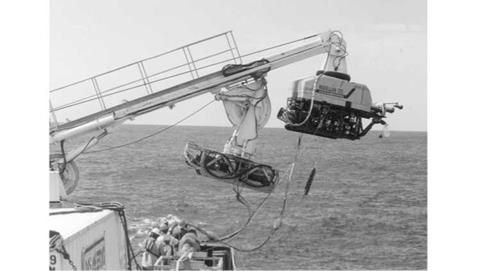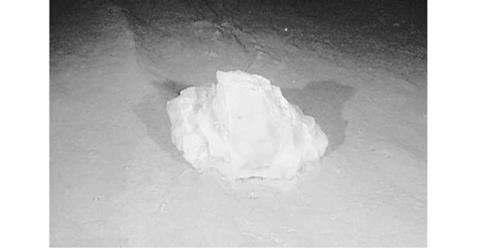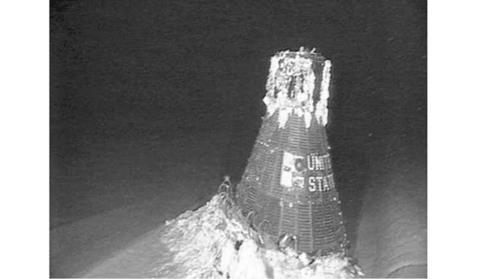FIRST EXPEDITION
Curt Newport’s team set sail on a two-week voyage on Monday, 19 April 1999. This time the Discovery Channel was paying for the entire expedition as well as filming the venture for a documentary to be broadcast in the fall. Everyone was hoping for a successful conclusion. The ship, the MV Needham Tide, was equipped with the very latest in side-scan sonar unit, although in reality the ship was barely suitable for a sonar search because of its propulsion system; it didn’t even have variable pitch propellers. The only way they could operate it sufficiently slowly to tow at 1.5 knots was to put one screw ahead and one astern, which they did for a whole week.
“We have a pretty good idea where to look for it,” Newport said prior to sailing. “To say I’m cautiously optimistic is probably the right term … this is a full-fledged, dedicated mission to go out and locate and recover this thing. We have a lot more time, we have a better sonar, we can examine a much larger area of the ocean at one time. Consequently, our chances are better. Outside of Challenger, this is the only one we haven’t gotten back. It’s the right thing to do. It’s patriotic. It was one of ours.”13
|
The Ocean Explorer 6000 side-scan sonar which was dragged over the bottom of the Atlantic in the target area and identified 88 sonar contacts. (Photo courtesy of Curt Newport) |
|
Curt Newport (left) reviews the 88 target sheets generated by the sonar search for likely contacts. (Photo: Discovery Channel, courtesy of Curt Newport) |
Misfortunate quickly set in when the side-scan sonar broke down, but once fixed it identified 88 possible targets scattered across the 24 square mile area that Newport had pinpointed based on 14 years of studying NASA charts and interviewing people who were there when Liberty Bell 7 went down, such as helicopter pilot Jim Lewis.
|
Launching the Magellan 725 ROV. (Photo courtesy of Curt Newport) |
On Saturday evening, 1 May, on Day 14 of the expedition, something bizarre happened. At 7:20 p. m., on the very first attempt and to everyone’s amazement, a vaguely familiar shape – a veritable ghostly apparition – emerged from the murky terrain as they stared at the video screen. Newport would not allow himself to get carried away; his first reaction was that it might be more large pieces of aircraft wreckage. After all, Target #71 was the very first object the Magellan Rover had closed in on. But as it drew nearer there was no mistaking the bell-shaped object with its rough exterior; it was the Mercury capsule Liberty Bell 7. Everyone, and especially Newport, was stunned at hitting the target first time.
“Everyone said that we simply got lucky. But it was not luck that we were looking in that area. Target 71 was one of a cluster of five hard contacts centered near my wind-corrected GBI FPS-16 radar location. That target was the first we looked at because it made sense from the operational standpoint, that is, from the positioning and navigational standpoints. In reality, the first target we found was a trail of LB7’s decomposed heat shield, which was scattered down a small rise from the capsule. We had no idea what we were looking at. I thought that it was aircraft debris. The next thing I knew, we were seeing this tall thing in the darkness up the hill.”14
From what they could see, the spacecraft appeared to be intact and the words Liberty Bell 7 could be clearly discerned on the side of the craft. And so could the false, painted crack. As Newport later pointed out, the spacecraft could easily have been obscured from the sonar and they might not have seen it in the gloom. Good fortune was certainly riding with them that day since it was a very small object in a massive area of ocean floor. “What we did find was something in water half a mile deeper than the Titanic and it’s smaller than one of the Titanic’s boilers.”15
Sadly, the team’s elation would not last long. At four minutes to midnight the cable to the remotely operated Magellan 725 ROV snapped in the rough seas and the rover
|
|
After five hours probing the depths, the Magellan ROV located some mysterious glistening chunks of white material Newport described as “space age bread crumbs” which led the team to Liberty Bell 7. (Discovery Channel image courtesy of Curt Newport)
|
|
The first ghostly images of Liberty Bell 7 captured in Magellan’s powerful lights. (Discovery Channel image courtesy of Curt Newport)
was lost, sinking to the sea floor 15,800 feet below the Needham Tide. It meant the team would have to abandon the operation and return to Port Canaveral to replace the rover, which would set them back a few weeks. But now they knew precisely where the capsule was. Despite the loss of an expensive ROV, Newport maintained a sense of optimism in a call he made from the ship. “It looks to be in beautiful condition,” he reported of the spacecraft, “and certainly capable of being recovered.”
The lost ROV would not remain on the ocean floor for long. “The Magellan 725 was later recovered about a week after we returned to the Cape with the capsule. I personally believe that Oceaneering would’ve left it there except for the expensive camera we had leased from WHOI. Woods Hole wanted that camera back, which was the same one we’d used to image the Titanic the previous year. They left the depressor and several thousand feet of armored optical fiber cable on the bottom simply by cutting the soft tether and lifting the ROV.”16
It would take Oceaneering International five weeks to construct another ROV, this time named Ocean Discovery. The expedition team sailed again on 4 July on a different ship, the Ocean Project. They stopped briefly at Fort Lauderdale to pick up a few people, including Jim Lewis, the helicopter pilot who had unsuccessfully attempted to rescue the sinking capsule in 1961, and Guenter Wendt, McDonnell’s former launch pad leader. Two bomb experts from UXB International were also on board to deactivate the explosive SOFAR navigation device which had apparently failed to detonate when the spacecraft sank.











